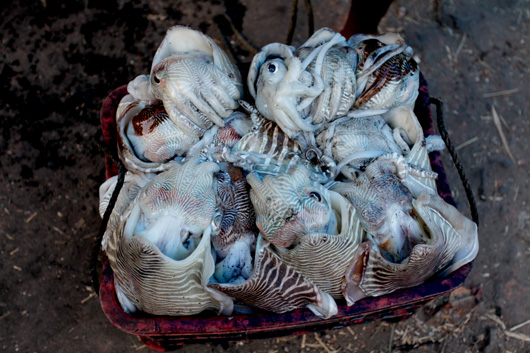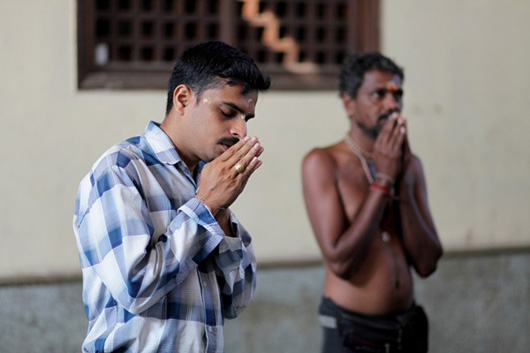So this is it, the end of the trip. Cameron is on the long flight back to Canada and -36 and we are left in Trivandrum in 36 degrees. Almost three weeks of non stop travel and good food, beautiful people and places.
After going to sunday church we waited to meet some members of the fishing community in Kollam, a medium size fishing town. It had had lots of money spent on it, three story flats and concrete, bars on windows and locks on doors. Its strange how money and so called progress makes such fundamental changes to the community. We managed to track down a local activist Andrews Ambrose who we hoped would open all kinds of doors for us but he didn't, he just closed his and said he would need to discuss our work with the committee, so we got in a car and found the local fish market just north of Kollam.
Sardines, millions of them, boat after boat, crate after crate, noise, smell and movement. It was amazing to see just how much in one small port, by just a few fishing boats could be landed. On an average day about 5,000 baskets each weighing around 30-40 kg are bought in, on a good day 10,000. These are big commercial boats that trawl the seas all night, from the beach after the sun has set it looks like a far off city of twinkling lights.
In the morning on Kovalam beach, I sat and watched around thirty local fishermen land their beach nets, from sunrise to about 9am they move across the beach with their ropes, singing rhythmically as they draw in the nets. The whole community working together then sharing what they bring in. This time as is now more the case, their nets were empty. Just a couple of crab, an eel and some small and terrified mackerel. There is such a disconnect with the business man who owns the boat and the people who work it to the resource they are harvesting. It merely becomes a financial transaction and is bereft of emotion, culture and respect. But hey, the fishermen have those wonderful tourists to fall back on!
On our way to Trivandrum, stopping at one of the wonderful Indian Coffee Houses. Puri bhaji and sweet milky coffee pulled us all together and we ended up in the kitchen to see what they were putting in the rather strange colored bhaji… it was all a bit suspect but turned out to be beetroot.
Then again to the amazing Laurie Baker designed Indian Coffee House in front of the train station. This circular building has a spiral dinning hall and over thirty tables, cool air and natural light, a far cry from the normal "hotel" eating joints we end up in.. blacked out glass a squeaky old fan blowing hot smoke and chillie filled air around the room while eliminated by the wonders of strip lighting. How simple it could all be if we though about more than just how to make a bit of money.
Coconuts seemed to be a good start so we headed off the main roads and stopped at coir villages. The book we will put together will be a combination of recipes and stories on food, the people the culture and the environment and how they are part of a whole. What has taken us ten thousands years of toil, understanding and respect is true sustainability, what we are being sold as food security and sustainability is little more than a resource grab. Its only when you travel deep into the villages that you begin to understand how it all works and how it needs to work.
So coconuts would be a perfect story for the book. From its religious, cultural significance, its water and milk, its flesh and its shell, for oil to cook and oil to burn, wood and leaves for building, fiber for materials and so we could go on. One tree with endless possibilities. So this is very much were we need to go with the project the connection to the source of our food and our cultures. Thank you Cameron for starting this up. And thank you Chintan, you've been amazing. Its going to work!
http://topdocumentaryfilms.com/the-coconut-revolution/
After going to sunday church we waited to meet some members of the fishing community in Kollam, a medium size fishing town. It had had lots of money spent on it, three story flats and concrete, bars on windows and locks on doors. Its strange how money and so called progress makes such fundamental changes to the community. We managed to track down a local activist Andrews Ambrose who we hoped would open all kinds of doors for us but he didn't, he just closed his and said he would need to discuss our work with the committee, so we got in a car and found the local fish market just north of Kollam.
Sardines, millions of them, boat after boat, crate after crate, noise, smell and movement. It was amazing to see just how much in one small port, by just a few fishing boats could be landed. On an average day about 5,000 baskets each weighing around 30-40 kg are bought in, on a good day 10,000. These are big commercial boats that trawl the seas all night, from the beach after the sun has set it looks like a far off city of twinkling lights.
In the morning on Kovalam beach, I sat and watched around thirty local fishermen land their beach nets, from sunrise to about 9am they move across the beach with their ropes, singing rhythmically as they draw in the nets. The whole community working together then sharing what they bring in. This time as is now more the case, their nets were empty. Just a couple of crab, an eel and some small and terrified mackerel. There is such a disconnect with the business man who owns the boat and the people who work it to the resource they are harvesting. It merely becomes a financial transaction and is bereft of emotion, culture and respect. But hey, the fishermen have those wonderful tourists to fall back on!
On our way to Trivandrum, stopping at one of the wonderful Indian Coffee Houses. Puri bhaji and sweet milky coffee pulled us all together and we ended up in the kitchen to see what they were putting in the rather strange colored bhaji… it was all a bit suspect but turned out to be beetroot.
Then again to the amazing Laurie Baker designed Indian Coffee House in front of the train station. This circular building has a spiral dinning hall and over thirty tables, cool air and natural light, a far cry from the normal "hotel" eating joints we end up in.. blacked out glass a squeaky old fan blowing hot smoke and chillie filled air around the room while eliminated by the wonders of strip lighting. How simple it could all be if we though about more than just how to make a bit of money.
Coconuts seemed to be a good start so we headed off the main roads and stopped at coir villages. The book we will put together will be a combination of recipes and stories on food, the people the culture and the environment and how they are part of a whole. What has taken us ten thousands years of toil, understanding and respect is true sustainability, what we are being sold as food security and sustainability is little more than a resource grab. Its only when you travel deep into the villages that you begin to understand how it all works and how it needs to work.
So coconuts would be a perfect story for the book. From its religious, cultural significance, its water and milk, its flesh and its shell, for oil to cook and oil to burn, wood and leaves for building, fiber for materials and so we could go on. One tree with endless possibilities. So this is very much were we need to go with the project the connection to the source of our food and our cultures. Thank you Cameron for starting this up. And thank you Chintan, you've been amazing. Its going to work!
http://topdocumentaryfilms.com/the-coconut-revolution/







































































